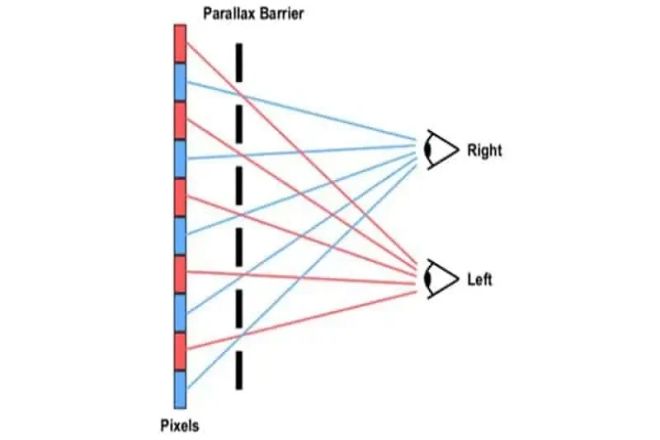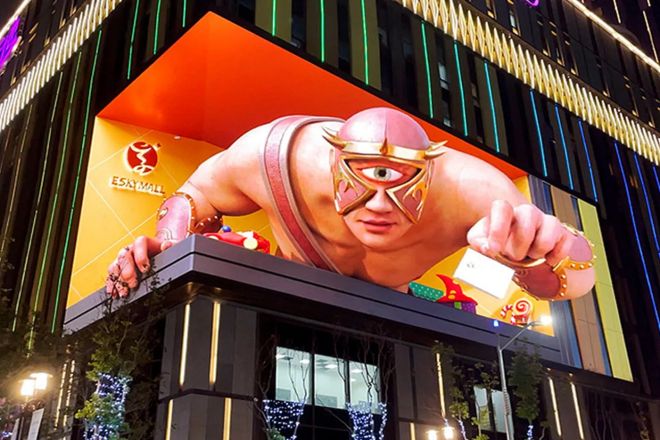序章

As LED表示 develops to this day, we often see many reports saying “LED display breaks through 3D and enters the 5D era” and so on, but why have we rarely seen 5D, 6D and other LED displays in our lives? What is the difference between them and 3D LEDディスプレイ?
This article will select a 5D LED display that is talked about the most and compare it with the 3D LED display that we often see. Let’s take a look.
1. Concept analysis of 3D LED display

As an outstanding representative of modern display technology, 3D LED display cleverly combines the high brightness, long life, and excellent color performance of LED (light-emitting diode) with advanced stereoscopic display technology to bring users an unprecedented visual feast.
This innovative display is not only a carrier of information but also a work of art that can stimulate the senses and create an immersive experience.
Its core advantage lies in its unique three-dimensional image display capability, which transcends the boundaries of traditional two-dimensional displays, allowing images to “jump onto the screen” and present a rich sense of depth and a broad sense of space. Behind this achievement is the perfect combination of sophisticated technical design and complex visual science principles.
Specifically, 3D LED displays take advantage of the natural parallax phenomenon of human eyes – that is, due to the slight difference in the position of the eyes, there are subtle differences in the images seen by the left and right eyes.
This difference information is processed in the brain and finally forms the three-dimensional world we perceive.
In order to achieve the naked eye 3D effect, 3D LED displays use a variety of technical means. First, through the high-precision LED dot matrix layout, it is ensured that each pixel can be accurately controlled to present a delicate and layered image.
Secondly, using advanced image processing algorithms, the original image is segmented, adjusted, and optimized to generate two slightly different images suitable for the left and right eyes, respectively. The two images are cleverly staggered on the display screen.
When the audience stands in a specific viewing position, the left and right eyes receive the corresponding image information, respectively, thereby synthesizing a three-dimensional visual effect in the brain.
In addition, in order to further enhance the viewing experience, the 3D LED display also uses wide-angle display technology and a high refresh rate design. Wide-angle display technology ensures that the audience can get a good three-dimensional effect at different angles, while the high refresh rate effectively reduces image smear and blur, making the picture smoother and more natural.
2. 5D LED display concept analysis
As a bright new star and a new milestone in the field of display technology, the name of 5D LED display is not a simple stacking of physical space dimensions or an expansion to five dimensions in a literal sense, but a creative expression that deeply reflects the integration of technological innovation and sensory experience.
It represents a revolutionary multimedia display form that aims to bring the audience into an immersive environment beyond reality in an unprecedented way, achieving multi-dimensional, deep sensory interaction and emotional experience.
Technological innovation is the core driving force behind the creation of a 5D LED display. This display integrates the most cutting-edge display technology, audio technology, and tactile feedback technology and may even include cutting-edge technologies such as odor release and taste simulation, together weaving a full-dimensional, multi-sensory immersive experience network.
In terms of vision, the high-definition and delicate LED screen combined with advanced 3D rendering technology presents a shocking three-dimensional picture, making the audience feel as if they are in the picture; in terms of hearing, the combination of surround sound effects and precise positioning audio technology creates a realistic sound environment and enhances the immersion of the scene.
In terms of touch, through physical feedback devices such as vibrating seats and wind effect devices, the audience can feel the action and atmosphere in the picture and achieve a synchronous experience of body and vision
Further, some high-end 5D LED displays may also introduce an odor release system to release corresponding odors according to scene changes, and try to simulate taste experience through special means, so that the audience’s sensory experience is unprecedentedly rich and real.
This all-round immersive experience not only greatly enhances the audience’s sense of participation and substitution but also makes information transmission and emotional communication more direct and profound.
In many fields, such as advertising, entertainment, education, and exhibitions, 5D LED displays have shown great application potential and value.
For example, in the 広告 field, it can attract consumers’ attention in a more vivid and interesting way enhance brand memory and purchase intention; in the entertainment industry, 5D cinemas, game halls, and other places use 5D LED display screens to create immersive experience spaces, bringing unprecedented entertainment enjoyment to the audience.
In the field of 教育 と 展示, 5D LED display screens can simulate real scenes and restore historical moments, making the learning and visiting process more intuitive, interesting and productive.
3. Technical comparison between 3D and 5D LED display screens

Significant technical differences exist between 3D and 5D LED display screens, which are mainly reflected in visual effects, technical implementation, application scenarios, and user experience.
1). Visual effect
- 3D LED display screen:
mainly through stereoscopic visual imaging technology, the audience can watch stereoscopic images with a sense of depth and space without wearing special glasses.
This technology projects different images to the left and right eyes, respectively, using the spatial 解決 ability of the human eye and the comprehensive processing of the brain nerves to present a three-dimensional visual effect.
3D LED display screens also have high performance in clarity, contrast, and color saturation, which can bring a more realistic and shocking visual experience to the audience.
- 5D LED display screen:
On the basis of 3D, it further integrates multi-sensory experience technology, including hearing, touch, smell, taste, etc., to create an immersive and full-dimensional experience.
Although the term “5D” is not accurate in physical dimensions, it does represent the progress of technology in providing richer and more complex sensory experiences.
5D LED display screens not only have excellent visual effects but also can make the audience feel as if they are in the scene of a movie, game, or exhibition through various means such as sound, vibration, smell, etc.
2). Technical realization
- 3D LED display screen:
mainly relies on stereoscopic imaging technology and high-resolution LED dot matrix technology. These technologies enable 3D LED display screens to present clear, delicate, and three-dimensional images.
At the same time, in order to enhance the viewing experience, 3D LED display screens may also use wide viewing angle technology and brightness/contrast adjustment technology to ensure that the audience can get good visual effects under different angles and lighting conditions.
- 5D LED display screen:
This is more complex and diverse in terms of technical realization. In addition to stereoscopic imaging technology and high-resolution LED dot matrix technology, 5D LED display screens also need to combine multiple devices and technologies such as sound systems, vibration devices, and odor-release devices to achieve the integration of multi-sensory experience.
In addition, in order to achieve a more accurate and personalized interactive experience, 5D LED display screens may also adopt advanced technologies such as dynamic interaction technology, environmental perception technology, and adaptive adjustment technology.
3). 応用シナリオ
3D LED display screens are widely used in commercial 広告, 展示会, cinemas, and other fields. In commercial advertising, 3D LED display screens can attract customers’ attention and enhance brand image and sales.
In exhibitions, 3D LED display screens can vividly display exhibits and enhance the audience’s sense of participation and memory points; in cinemas, 3D LED display screens can bring audiences a more realistic and shocking viewing experience.
5D LED display screens are used more in theme parks, science and technology 博物館, museums, and other places that require high interactivity and immersion.
In these places, 5D LED display screens can combine other equipment and technologies to create a rich and diverse interactive experience scene, making the audience feel as if they are in a world full of fantasy and surprises.
4). User experience
- 3D LED display:
By providing stereoscopic visual effects and high-quality image display, it brings a more realistic and shocking visual experience to the audience. However, this experience is mainly limited to the visual aspect and lacks the participation of other senses.
- 5D LED display:
Integrating multi-sensory experience technology provides the audience with a more comprehensive and in-depth immersive experience.
The audience can not only see the stereoscopic images, but also hear realistic sound effects, feel the vibration touch, and smell specific smells.
This all-around sensory experience allows the audience to participate more deeply in the scene and gain a richer and deeper emotional experience.
In fact, the LED display products are the same, but there are some adjustments in the installation location and shape.
The main reason is that the video sources of 3D and 5D are very different, and 5D adds other sensory experiences on the basis of 3D visual effects.
5D is generally used for 屋内 entertainment projects, movies or theme exhibitions, and 3DLED displays are basically displayed outdoors and indoors.
4. As an investor, which LED display is more beneficial, 3D or 5D?
For investors, 3D LED displays and 5D LED displays each have their own unique advantages and applicable scenarios, so it is impossible to simply judge which one is more beneficial. The following is a detailed analysis of the two displays:
1). 3D LED display
1.1) 利点:
High exposure: 3D LED displays are usually installed in geographical locations with large traffic and high exposure, such as commercial centers, outdoor billboards, etc., which can attract the attention of a large number of viewers and improve the communication effect of advertising.
Advertising revenue: By playing advertising content, investors can obtain advertising fees as a source of revenue. In areas with dense traffic, advertising revenue is often very considerable.
Mature technology: 3D LED display technology is relatively mature, there are many successful cases and stable supply chain in the market, and it is relatively easy for investors to choose and operate.
1.2) 適用可能なシナリオ:
Outdoor billboards, Commercial center large screens, スタジアム, concerts, and other large-scale events
2). 5D LED display
2.1) 利点:
Immersive experience: A 5D LED display can provide audiences with an immersive viewing experience through special effects such as vibration, water spray, wind, etc., while playing the film, enhancing entertainment and interactivity.
High added value: Due to the unique immersive experience, 5D LED display screens often attract more tourists and audiences, thereby bringing higher ticket or experience fees.
Strong innovation: 5D LED display screens represent the innovative direction of display technology and are highly attractive to investors who pursue novel and unique experiences.
2.2) 適用可能なシナリオ:
Indoor amusement parks, Movie theme rooms. Educational and entertainment venues such as science and technology museums and 博物館
3). Investment advice
When choosing 3D or 5D LED display screens, investors should consider their investment goals, financial strength, market positioning, and the needs of the target audience.
If investors want to obtain advertising revenue quickly and reduce operating risks, then 3D LED display screens may be a more secure choice.
If investors pursue innovation and high-added value and are willing to bear certain market risks and operating costs, then 5D LED display screens may bring greater returns.
In short, both 3D LED display screens and 5D LED display screens have their unique advantages and applicable scenarios. Investors should make wise choices based on their own circumstances.
結論
With the end of our joint exploration, I believe you have a clearer understanding of the difference between 3D LED displays and 5D LED displays. From simple visual shock to a full-scale sensory feast, technological progress has not only broadened our horizons, but also enriched our life experience.
最後に、LEDディスプレイについてもっと知りたい方は、 ご連絡ください。
